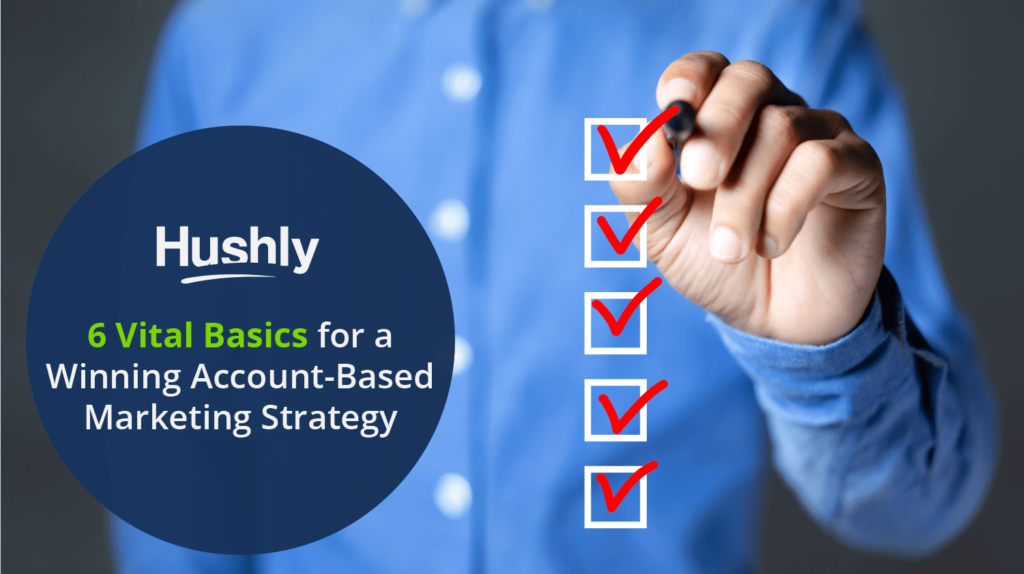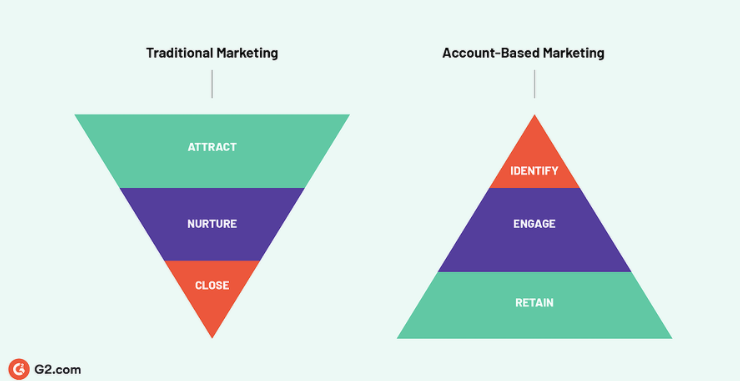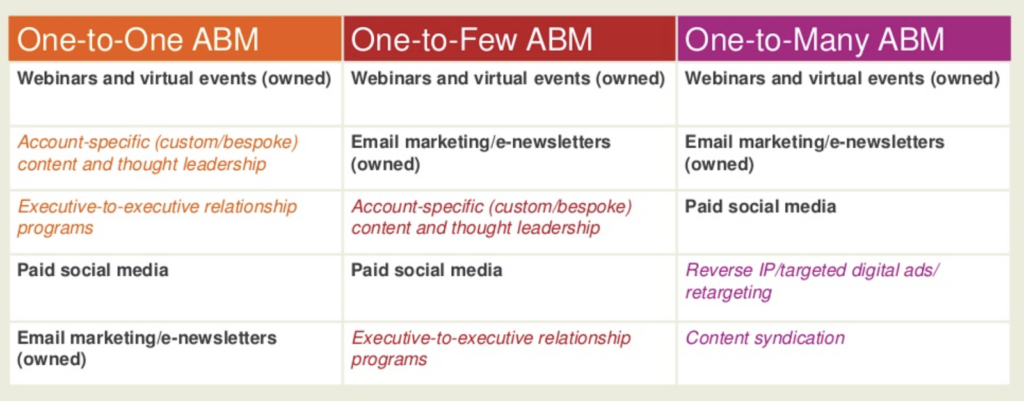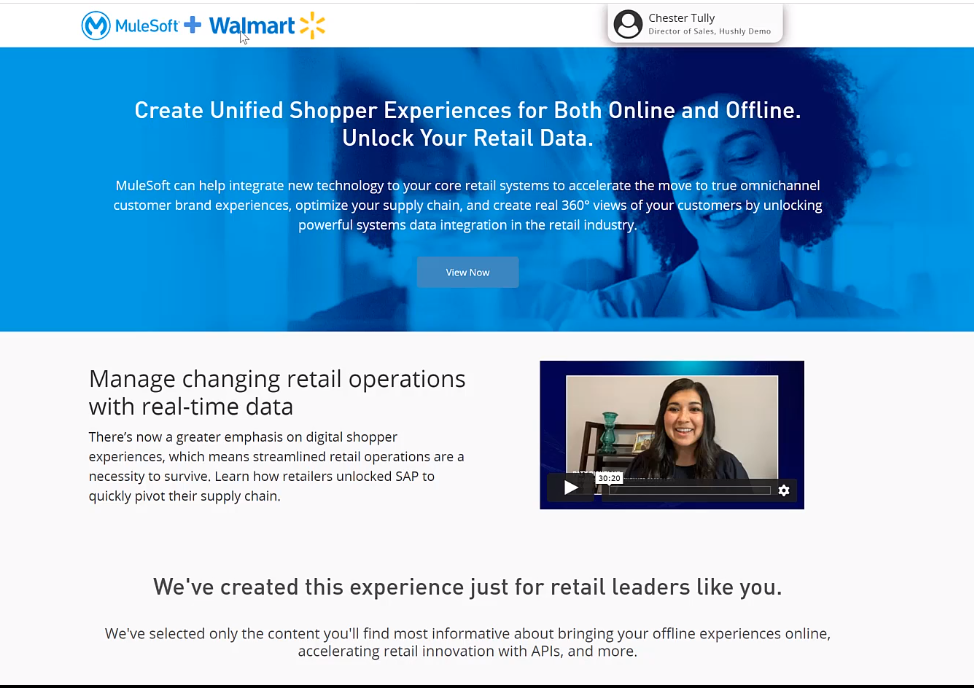Imagine how you feel when you open an email from your favorite brand.
It mentions your first name in the To field. The subject line is something simple like “Happy Friday.”
The body is filled with personalized clothing recommendations based on what you’ve bought and browsed before. They might even let you know the expensive piece you’ve had your eye on for months dropped in price this week.
Although almost every part of that email was automated, it still feels personal.
Most importantly, it’s relevant and useful.
You can achieve a similar feeling and result for your B2B clients through account-based marketing.
Following these account-based marketing basics ensures your content and messages are always completely relevant and useful.

What is Account-Based Marketing?
You’ll often see ABM described as an inverted funnel:

Instead of casting a wide net to lure prospects and nurture leads, you identify target accounts and leads first. Building backward, you study each individually.
Your account-based marketing framework can focus on an entire organization, segments of the team, or individual employees. It all depends on what you know about the account, how your brand fits in, and what you want to achieve.

You create relevant content, engage leads earn their trust, and hopefully convert them into customers.
Finally, you use what you’ve learned about each account and any new data to build their loyalty and keep their business.
ABM is much more sustainable than traditional marketing because it incorporates post-purchase nurturing in a way other strategies can’t.
In 2019, nearly a quarter of marketers said they had no active ABM strategy. By the same time next year, less than 6% reported to have no ABM.
This surge in adaptation – during the squeeze of a global pandemic no less – just proves the benefits of ABM like:
- Increased ROI compared to traditional B2B marketing
- Retaining existing customers and improving customer service
- Accelerating the sales funnel and improving nurturing
Furthermore, successful ABM requires that sales, marketing, and customer service don’t just play nice but remain actively engaged in each other’s work. As you can imagine, that benefit reverberates throughout your entire organization in more ways than you can quantify.
How to Set Up Your Account-Based Marketing Framework and Tactics
Even ten years ago, small- and mid-size businesses would never even dream of launching ABM. Only major corporations with massive budgets could afford spending the time and resources targeting specific accounts.
Today, AI-driven technology and automation make it easy for anyone to develop an account-based marketing framework.
Here are the account-based marketing basics every marketer needs to know if they want to see results.
1. Select Your Target Accounts
Think long-term here. One high-value sale sounds nice but with ABM, you want long-term customer retention. It’s just more cost-effective and efficient.
As you build your list of potential target accounts (which can range from 50 to over 1,000), ask questions like:
- What is the account’s estimated lifetime value?
- What kind of post-purchase customer service and support will they need?
- How much will it cost and how long will it take to win this account?
2. Create Personas for Each Account and Segment
Your personas depend on which type of ABM you run:
- One-to-one
- One-to-few
- One-to-many
With your type of account-based marketing framework in mind, you can figure out whether you need to build hyper-focused personas for individuals, teams, or more general personas for accounts.
Of course, more details are always better but when you’re targeting hundreds of accounts, you can only do so much.
3. Unite Sales, Marketing, and Customer Service
Of all the account-based marketing basics, this one is the most important.
Why? Well, ABM is not like traditional marketing tactics, so a traditional team approach won’t work either.
Consider just the customer retention stage of ABM:
- Customer service reps are the first human touchpoint for questions/concerns – not sales.
- Marketing must produce educational content that reduces the need to contact customer service.
- Sales must coordinate with marketing and customer service for upsells and renewals.
Ongoing conversations and internal educational content are key to pulling off successful ABM.
4. Research and Develop a Content Strategy
Your account persona research should drive your content. Your biggest job now is to set KPIs for your content and plan the strategy.
With ABM, there’s no excuse for generic content because you already know who you’re targeting. Make sure to include details like:
- How you can help them reduce costs, using case studies for similar accounts as examples.
- Why you can solve their specific problems better than the competition.
- How you can scale and grow with them long-term.
5. Optimize Your Website for User Experience
Personalization is a top priority here.
When someone from a target account visits your website, you ideally want them to see a custom version with all the content, discounts, service, and pricing you’ve created just for them.
An AI content recommendation engine helps here.
The AI system will study which case studies, topics, and other pieces of content a visitor browses. The AI notes the specific industry, account, and stage of the funnel to suggest the next best piece of content.
Custom ABM campaign pages are also important.
Use templates to personalize content assets, case studies, pricing, and offers by industry. Then break the pages down further for each target account – complete with logo and an assigned rep. Like so:

6. Launch, Connect, Measure, and Adjust
The personal nature of ABM means there’s plenty of room for mistakes – or improvement depending on how you look at it.
Evaluate your engagement/awareness KPIs after a month or two and your sales/retention figures quarterly. Don’t forget to rerun your account research before tweaking content or overhauling your landing pages.
Account-Based Marketing Basics: Start with the Right Tools
Behind every winning account-based marketing framework you’ll find carefully configured tools. For countless B2Bs, Hushly powers the bulk of their ABM tools.
From customizable ABM campaign pages and AI-powered content recommendation engines to smart microforms and engaging exit-intent popups, we always have your back and your audience’s best interests in mind.
Rethink personalization with Hushly’s customizable ABM Campaign Pages and templates.




